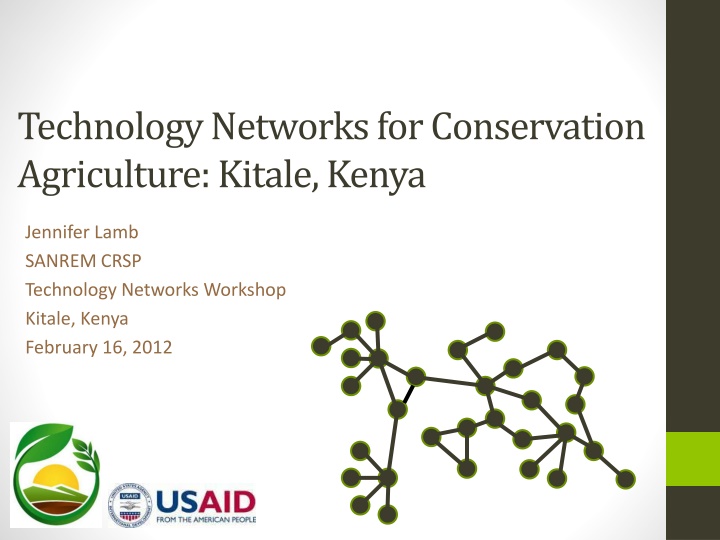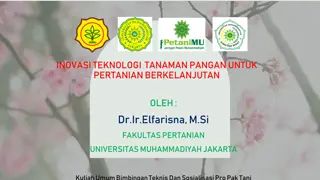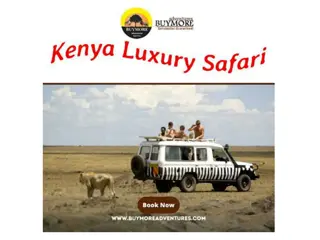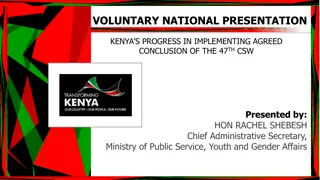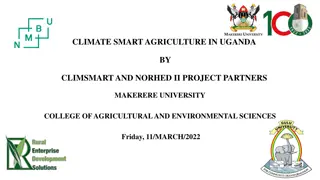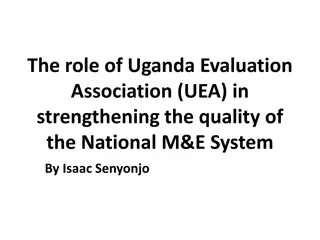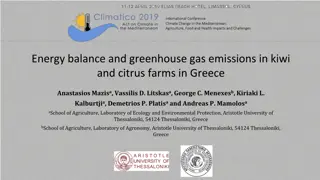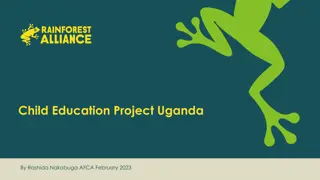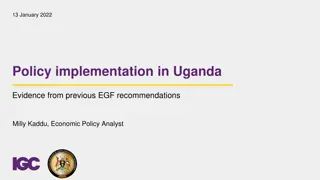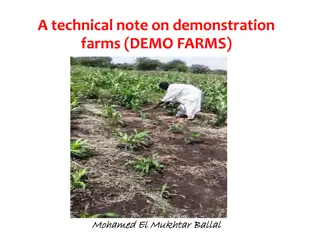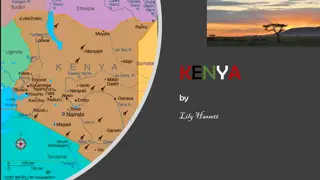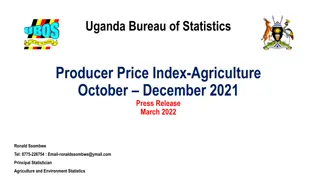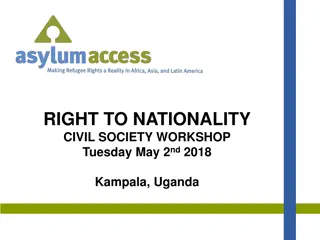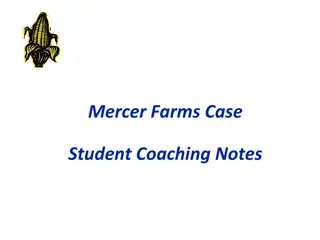Sustainable Agriculture Practices for Small-holder Farms in Kenya and Uganda
The project focuses on the development and implementation of Conservation Agriculture Production Systems (CAPS) to improve soil fertility and crop yields for small-holder farms in Eastern Uganda and Western Kenya. Key principles include crop rotation, maintaining crop cover, and minimizing tillage. By working with universities, NGOs, and local farmer groups, the project aims to promote sustainable farming practices and enhance food security in the region.
Download Presentation

Please find below an Image/Link to download the presentation.
The content on the website is provided AS IS for your information and personal use only. It may not be sold, licensed, or shared on other websites without obtaining consent from the author.If you encounter any issues during the download, it is possible that the publisher has removed the file from their server.
You are allowed to download the files provided on this website for personal or commercial use, subject to the condition that they are used lawfully. All files are the property of their respective owners.
The content on the website is provided AS IS for your information and personal use only. It may not be sold, licensed, or shared on other websites without obtaining consent from the author.
E N D
Presentation Transcript
Technology Networks for Conservation Agriculture: Kitale, Kenya Jennifer Lamb SANREM CRSP Technology Networks Workshop Kitale, Kenya February 16, 2012
What is the project? Lead institution: University of Wyoming Development and Transfer of Conservation Agriculture Production Systems (CAPS) for Small-holder Farms in Eastern Uganda and Western Kenya
Who are the implementing partners? Universities: University Of Wyoming Makerere University Moi University Ngo s: AT Uganda Manor House Sacred Africa Local Farmer Groups/Key Stakeholders
Core Principles of Conservation Agriculture Three principles: 1. Crop rotation Mixing and rotating crops which maintain/improve soil fertility 2. Maintaining a permanent crop cover The soil should be covered as much as possible 3. Minimizing tillage Disturb the soil as little as possible
Mix and rotate crops Conventional farming: Same crop is sometimes planted each season Allows certain pests, diseases and weeds to survive and multiply, resulting in lower yields. Conservation agriculture: This is minimized by: Planting the right mix of crops in the same field Rotating crops from season to season that require different nutrients from the soil. Helps to maintain soil fertility.
Maintaining crop cover Conventional farming: Remove or burn the crop residues or mix them into the soil with a plough or hoe Soil is left bare, so it is easily washed away by rain, or is blown away by the wind. Conservation agriculture: Crop residues left on the field Mulch and special cover crops protect the soil from erosion Helps limit weed growth throughout the year.
Minimizing Tillage Conventional farming: farmers plough/hoe to improve the soil structure and control weeds. Over the long term, this: destroys the soil structure contributes to declining soil fertility Conservation agriculture: Tillage is reduced to ripping planting lines or making holes for planting Ideal: plant direct into the soil Accomplished without plowing/disturbing the rest of the field
SANREM Principles and procedures Working with partners in the targeted research communities Understanding values of activities to community members How community members benefit Created local advisory councils why you are here today
Principles and procedures Research Project Objective: Develop new knowledge to be applied by community members Project does not have the resources to provide inputs, means for achieving development on a large scale Learning partnerships: Researchers committed to learning from community members Production systems and way of life Communities should benefit by Learning about their resources, potentials How to build more sustainable and profitable systems
Principles and procedures Conducts research with individuals and communities is on a voluntary basis. Successful learning occurs when individuals choose of their own accord to think and act in new ways. Our job is to present and test new ideas and technologies with those communities and community members who are interested in actively learning about new ways to manage their resources.
What is conservation tillage? Conservation tillage is any method of soil cultivation that leaves the previous year's crop residue (such as corn stalks or wheat stubble) on fields before and after planting the next crop, to reduce soil erosion and runoff. To provide these conservation benefits, at least 30% of the soil surface must be covered with residue after planting the next crop. Some conservation tillage methods forego traditional tillage entirely and leave 70% residue or more.
Why practice conservation tillage on your land? Environmental benefits Reduces soil erosion by as much as 60%-90% depending on the conservation tillage method; pieces of crop residue shield soil particles from rain and wind until new plants produce a protective canopy over the soil Improves soil and water quality by adding organic matter as crop residue decomposes; this creates an open soil structure that lets water in more easily, reducing runoff Reduces potential air pollution from dust and diesel emissions Crop residue provides food and cover for wildlife Conserves water by reducing evaporation at the soil surface Conserves energy due to fewer tractor trips across the field
Practical benefits Fewer trips across the fields saves time and money (lowers fuel, labor and machinery maintenance costs) reduces soil compaction that can interfere with plant growth Optimizes soil moisture, enhancing crop growth in dry periods or on droughty soils
Where we are in the process This is a 4 year project. We have 3 years left. Baseline data collection conducted year 1 Understand the local production system before the project Includes trying to understand what people s thinking about CA was before we started. Today s presentation is to show you some of the results of that baseline study. We have also completed the first year of experimental trials to begin testing CA principles Results are being analyzed. Will also be shared with you soon.
Types of CA Tillage Methods Conservation tillage is especially suitable for erosion-prone cropland. In some agricultural regions it has become more common than traditional moldboard plowing. Conservation tillage methods include no-till, strip-till, ridge-till and mulch-till. Each method requires different types of specialized or modified equipment and adaptations in management. No-till and strip-till involve planting crops directly into residue that either hasn't been tilled at all (no-till) or has been tilled only in narrow strips with the rest of the field left untilled (strip-till).
Additional Types of CA Ridge-till involves planting row crops on permanent ridges about 4-6 inches high. The previous crop's residue is cleared off ridge-tops into adjacent furrows to make way for the new crop being planted on ridges. Maintaining the ridges is essential and requires modified or specialized equipment. Mulch-till is any other reduced tillage system that leaves at least one third of the soil surface covered with crop residue.
Researching Technology Networks for CA Successful Conservation Agriculture Broad based support network Change in mindset regarding agricultural production practices Everyone has to be involved Why we have tried to bring you all here today
Research Process Focus Groups in 2010 Identify key contacts for agricultural production List of 21 key actors Survey conducted in 2010 79 farm households were asked about their key contacts for agricultural information/resources in Trans-Nzoia District Kibomet and Milimani Sub-locations Follow up interviews conducted with 21 individuals in 2011 Community agents Agricultural service providers Workshop today
Research Aims Understand existing mindsets with regard to agricultural production hekima kwa kilimo Especially with regard to conservation agriculture Map the structure of agricultural production networks (ya mtandao wa kulimo) in Tranz-Nzoia District Prioritized Identifying: Key contacts or nodes in the network For farmers (kwa mkulima) In the whole agricultural production network (kwa kila mtu katika matandao wa kulimo) Knowledge and beliefs about CA Differences between farmers and service providers/community agents
Farmer Involvement in Agricultural Networks Standard Deviation Min Value Max Value Variable Resource Contacts Observations Mean 79 5.72 2.54 0 11 Information Contacts 79 7.50 4.59 0 18
Key Resource Contacts for Farmers Agent Type: Number of Reports (Out of 79): Percentage of Farmers Reporting Contact: Vendor in a agro-vet shop Veterinary Service provider Government Parastatals Tractor owner/ animal traction provider Neighbor/friend Agricultural researcher Family Member Agricultural/Micro Finance Representative Government Extension agent Vendor in a shop in urban center Village/Subcounty chief Vendor in weekly market NGO/ Development Agent Leader of farmer organizations Leader of women s organization Teacher in village Leader of youth organisation Minister/Priest/Imam in village Local Political leaders 68 68 55 54 45 30 26 22 19 18 11 11 7 6 5 3 3 1 0 86% 86% 70% 68% 57% 38% 33% 28% 24% 23% 14% 14% 9% 8% 6% 4% 4% 1% 0%
Key Information Contacts for Farmers Number of Reports (Out of 79): Percentage of Farmers Reporting Contact: Agent Type: Vendor in a agro-vet shop Veterinary Service provider Government Parastatals Neighbor/friend Government Extension agent Family Member Village/Subcounty chief Agricultural researcher Tractor owner/ animal traction provider Agricultural/Micro Finance Representative Leader of farmer organizations Local Political leaders Leader of women s organization Leader of youth organisation Vendor in a shop in urban center NGO/ Development Agent Vendor in weekly market Minister/Priest/Imam in village Teacher in village 69 64 59 54 41 37 36 33 31 22 21 21 20 17 16 16 15 11 10 87% 81% 75% 68% 52% 47% 46% 42% 39% 28% 27% 27% 25% 22% 20% 20% 19% 14% 13%
Network Structure Matched the farmer data (79) to Technology Networks Data (21) Determine Influential Nodes: Degree Centrality = Number of contacts for agricultural information Betweenness Centrality = Score which indicates the extent to which an agent controls the transmission of information between contacts Degree Centrality Betweeness Centrality Rank Agent 1 Ministry of Agriculture 20 20.87 2 Microfinance Institutions 20 20.05 3 Stakeholder Forum 20 17.29 4 NGO 17 11.23
Knowledge and Beliefs about Agricultural Production Focus on the Three Principles of CA: 1. Crop rotation 2. Maintaining a permanent crop cover 3. Minimizing tillage Corresponding statements on questionnaire: Rotating crops is always best practice One should maintain a permanent crop cover Tillage causes land degradation Farmers indicated agreement on a scale of 1-5 5 = strongly agree 1= strongly disagree
Disaggregating Knowledge and Beliefs about Agricultural Production Differences between farmers and community agents/service providers? Farmers (n=79) Service Providers (n= 21) Differences between smaller and larger farmers? Are small or large farmers more predisposed to CA? Small farmer = 5 acres or less (n= 38) Large farmer = more than 5 acres (n=41) Differences between farmers with extension contact and without extension contact? Extension might expose farmers to CA views? Farmers without extension contact for information (n=38) Farmers with extension contact for information (n = 41)
Knowledge and Beliefs about Agricultural Production Beliefs about Agricultural Production Uncertain/ neutral Agree Disagree Small Farmers (38) 55.3 23.7 21.1 One should maintain a permanent crop cover Large Farmers (41) 39.0 22.0 39.0 Service sector/ (21) community agents Small Farmers (38) 66.7 14.3 19.0 Tillage causes land degradation 55.3 13.2 31.6 Large Farmers (41) 43.9 14.6 41.5 Service sector/ (21) community agents Small Farmers (38) 61.9 4.8 33.3 Rotating crops is best practice 94.7 5.3 0.0 Large Farmers (41) 95.1 2.4 2.4 Service sector/ (21) community agents 95.2 0.0 4.8
Rotating Crops is Best Practice 95.2 95.1 94.7 100 90 80 70 60 50 40 30 20 5.3 4.8 10 2.4 2.4 0 0 0 Small Farmers (38) Large Farmers (41) Service sector/ community agents (21) Agree Uncertain/neutral Disagree
One Should Maintain a Permanent Crop Cover 80 66.7 70 60 55.3 50 39 39 40 30 23.7 22 21.1 19 20 14.3 10 0 Small Farmers (38) Large Farmers (41) Service sector/ community agents (21) Agree Uncertain/neutral Disagree
Tillage Causes Land Degradation 70 61.9 60 55.3 50 43.9 41.5 40 33.3 31.6 30 20 14.6 13.2 10 4.8 0 Small Farmers (38) Large Farmers (41) Service sector/ community agents (21) Agree Uncertain/neutral Disagree
Impact of Extension Contact on Knowledge and Beliefs One should maintain a permanent crop cover Uncertain/ neutral Agree Disagree Mean values 3.16 a Farmers w/o contact (n=38) 36.8 26.3 36.8 3.63 ab Farmers with contact (n=41) 56.1 19.5 24.4 Service sector/community agents (n=21) 3.86 b 66.7 14.3 19.0 Note= different letters in the same column are significantly different from one another
Impact of Extension Contact on Knowledge and Beliefs Tillage causes land degradation Uncertain/ neutral Agree Disagree Mean values 3.21 a Farmers w/o contact (n=38) 44.7 15.8 39.5 3.37 a Farmers with contact (n=41) 53.7 12.2 34.1 Service sector/community agents (n=21) 3.57 a 61.9 4.8 33.3 Note= different letters in the same column are significantly different from one another
MAPPING KNOWLEDGE AND BELIEFS IN AGRICULTURAL PRODUCTION NETWORKS
Tillage causes land degradation Strongly agree Agree Uncertain/neutral Disagree Strongly disagree Not interviewed Tillage causes land degradation Mapped Network of Agricultural Information flows and actor beliefs
Strongly agree Agree Uncertain/neutral Disagree Strongly disagree Not interviewed One should maintain a permanent crop cover Mapped network of information flows and beliefs
How can we use this information to promote CA within the agricultural production network? Who does not understand CA? What don t they understand? What do they need to know? Who in the network could help them understand CA? Who might be missing from the network? What are the remaining challenges (agronomic, economic, practical, etc.) to be resolved for successful CA in Trans-Nzoia? Who needs to be brought together to resolve these issues?
